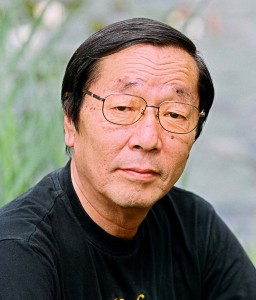Masaru Emoto facts for kids
Quick facts for kids
Masaru Emoto
江本勝 |
|
|---|---|
 |
|
| Born | July 22, 1943 Yokohama, Japan
|
| Died | October 17, 2014 (aged 71) Japan
|
| Education | Yokohama Municipal University |
| Spouse(s) | Kazuko Emoto |
Masaru Emoto (江本 勝, Emoto Masaru, July 22, 1943 – October 17, 2014) was a Japanese businessman, author and pseudoscientist who claimed that human consciousness could affect the molecular structure of water. His 2004 book The Hidden Messages in Water was a New York Times best seller. His ideas had evolved over the years, and his early work revolved around pseudoscientific hypotheses that water could react to positive thoughts and words and that polluted water could be cleaned through prayer and positive visualization.
Starting in 1999, Emoto published several volumes of a work entitled Messages from Water, containing photographs of ice crystals and accompanying experiments such as that of the "rice in water 30 day experiment."
Biography
Emoto was born in Yokohama, Japan, and graduated from Yokohama Municipal University after taking courses in International Relations. He worked in the Nagoya Office (Central Japan Office) of the Yomiuri Shimbun newspaper, then founded the International Health Medical company in 1986. In 1989, he received exclusive rights to market the Magnetic Resonance Analyzer, a device patented by Ronald Weinstock (Patent 5,592,086), which was alleged to be able to detect the magnetic field around a human hair, for example, and diagnose almost any disease. He renamed it the "Vibration-o-Meter," became an operator himself, and started a business dealing in vibrations.
He was President Emeritus of the International Water For Life Foundation, a non-profit organization based in Oklahoma City in the United States. In 1992, he became a Doctor of Alternative Medicine at the Open International University for Alternative Medicine in India, a fraudulent college which targeted quacks to sell degrees and was later shut down.
Ideas
Emoto claimed that water was a "blueprint for our reality" and that emotional "energies" and "vibrations" could change its physical structure. His water crystal experiments consisted of exposing water in glasses to various words, pictures, or music, then freezing it and examining the ice crystals' aesthetic properties with microscopic photography. He claimed that water exposed to positive speech and thoughts created visually "pleasing" ice crystals, and that negative intentions yielded "ugly" ice formations.
Emoto held that different water sources produced different ice structures. For example, he held that water from a mountain stream, when frozen, showed structures of beautifully shaped geometric designs; but that water from polluted sources created distorted, randomly formed ice structures. He held that these changes could be eliminated by exposing water to ultraviolet light or certain electromagnetic waves.
In 2008, Emoto published his findings in the Journal of Scientific Exploration, a journal of the Society for Scientific Exploration that has been criticized for catering to fringe science. He co-conducted and co-authored the work with Takashige Kizu of Emoto's own IHM General Institute, and Dean Radin and Nancy Lund of the Institute of Noetic Sciences, which is on Stephen Barrett's Quackwatch list of questionable organizations.
See also
- Water memory
- Polywater
- Water (2006 film)
- Pseudoscience
- Quantum mysticism

